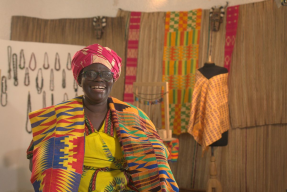Participating in the Dialogue: The Role of Microfinance Critics (Part 1)
December 18, 2010
As a Kiva Fellow and ardent believer in the poverty alleviating potential of microfinance, I make an effort to keep abreast the developments and discussions within the industry, both from the practical and academic side. While I find myself frustrated over negative articles or comments that oppose much what I am witnessing as a fellow on the ground, I must remind myself that this criticism can lead to constructive debates, and ultimately to advancements and improvements within the field.
The microfinance industry is certainly not without problems, as we have witnessed with recent events in Andhra Pradesh, India; however, the focus on the negative can tend to overshadow the good work and responsible lending being practiced by MFIs worldwide. Two criticisms of microfinance have come to my attention in the past week. One is Danish documentary filmmaker Tom Heinemann’s widely discussed “Caught in Micro Debt,” which premiered on Norwegian television on November 30, 2010; the other is an Aaron Ausland’s Huffington Post article, which explains “How Microfinance Lost its Soul”.
In this first post, I will discuss Ausland’s claim that microfinance has lost its soul, in other words that microfinance institutions (MFIs) have undergone “mission drift”.
Ausland’s critique of the current state of the microfinance industry is rooted in the accurate notion that microfinance and MFIs, the vehicles through which microfinance operates, were created with a poverty alleviating mission – and the debatable notion that efforts to expand reach (for example through the commercialization of financial institutions) necessarily have a detrimental effect on these institutions’ ability to serve the poor.
Based on my experience, Ausland is missing two main points in his assessment of the current situation:
- Microfinance was born out of the absence of financing options for the world’s poor, and as developing countries’ financial systems develop and diversify, the character and profile of MFIs will also develop and shift.
- This expansion and diversification of the financial landscape (particularly the movement of certain microfinance providers upmarket) does not necessarily imply the removal of financing options for the poor, or a lack of options downmarket.
Ausland cites six shifts he has witnessed within the field of microfinance; while all six raise interesting and relevant questions, I will focus on two here, namely targeting the poorest of the poor versus the moderately poor and group versus individual lending.
Shift from targeting poorest of poor to the moderately poor
While it may at one point have been the proclaimed focus of microfinance to reach the poorest of the poor, this entails obvious challenges that the microfinance community has long since recognized – the question of whether microfinance has ever, or is even able, to reach the poorest of the poor is widely debated.
Each day, on my commute to ProMujer’s El Alto office, I walk up a set of stairs where there are inevitably 4-5 people sitting, suffering, with their hand out asking for change. While my heart breaks for them and the knowledge that their country (and international community) isn’t adequately able to take care of their basic needs, I also realize that microfinance is not the right tool to address their problems. The poorest of the poor is comprised of the world’s weak and vulnerable, often old or disabled, who lack more than working capital to survive and improve their lives.
For this reason, I would argue that, though efforts have been made to do so, it is not a reasonable expectation for microfinance to serve the absolute poorest. Microfinance should be offered in conjunction with a greater variety of programs and tools, and in the case of the poorest of the poor, public programs offering food, clothing, and healthcare are more likely to have an impact on their lives than micro-loans.
Shift from peer lending to individual collateralized lending
Ausland correctly identifies group lending as the initial solution to the incentives question of being able to lend to poor people. Solidarity groups, village banks, and group loans have, throughout the world, have proven to be an effective way to get capital to poor people while decreasing the risk involved in doing so.
In Bolivia, MFIs have increased individual lending at the request of clients. Dependence on (for example) 19 other women for access to financial services, while preferable to no access at all, can be a burden for the members. Thanks to improvements in the country’s Credit Bureau (Central de Riesgos), institutions are more easily able to assess a potential client’s loan history, both to determine whether he/she has defaulted on previous loans and to view how many outstanding loans he/she currently has (in order to protect against over-indebtedness). In my view, this represents a shift towards the model being used in developed countries, and in essence a closing of the gap in the financial systems of developing countries that have historically, perpetually exclude poor people.
Although Bolivia has seen some of the shifts noted by Ausland, I question the notion that these changes in the microfinance landscape have left poor people worse off. Wasn’t the original idea of microfinance to facilitate access to financial services for people that had previously been excluded? In this light, doesn’t an expansion and diversification of financing possibilities signal success rather than failure? It is of course a failure if the socially oriented financial institutions are moving upmarket and not looking back. But as I see it, the institutions with social missions continue to target the poor, while the financial institutions that move towards serving “less poor” clients are responding to a need created by shifting demographics and citizens’ needs.
Stay tuned for my next blog post, in which I will draw on my experience in Bolivia to consider some of the points raised in Tom Heinemann’s documentary.
Background information on the history of microfinance in Bolivia provided by Elizabeth Rhyne’s Commercialization and Crisis in Bolivian Microfinance.
Julie Shea, KF13, Bolivia
PREVIOUS ARTICLE
Falling in love with the Philippines…One song at a time →NEXT ARTICLE
A Farm for the Poorest of the Poor →













